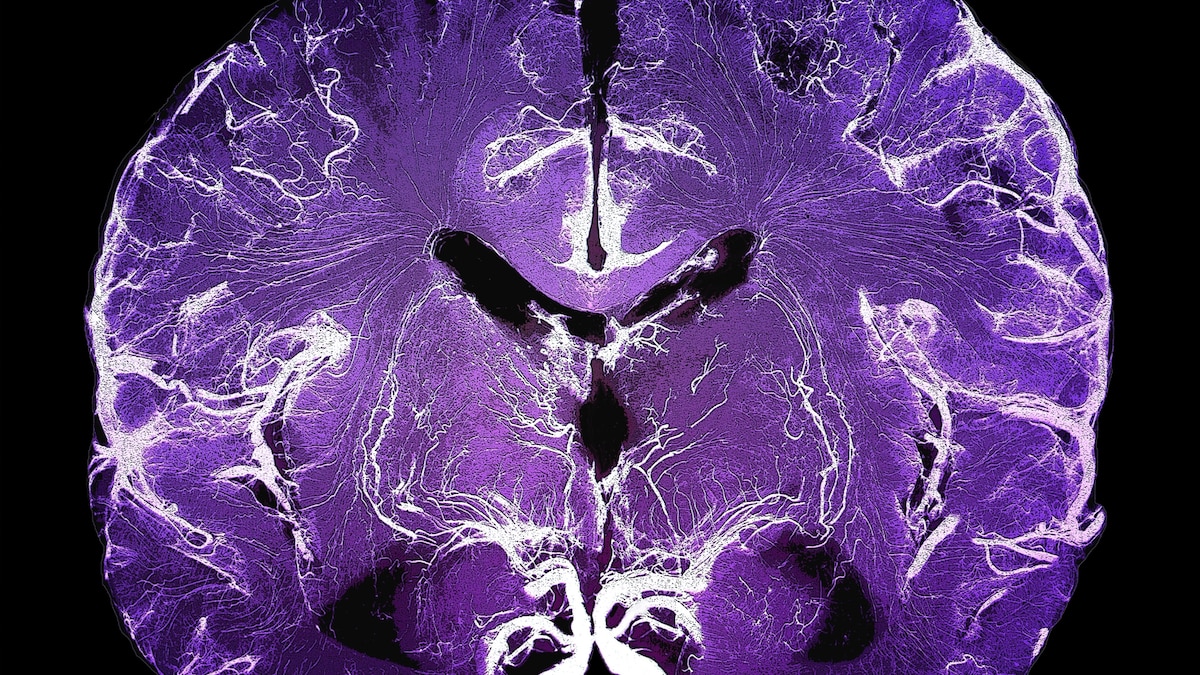Now Reading: The real science of brain rot
-
01
The real science of brain rot
The real science of brain rot

In 2024, the Oxford University Press declared “brain rot” the word of the year. If Ohio is just a midwestern state to you and mewwing is something your cat does, you might not be as familiar with the term as those who have adopted the Gen Z and Alpha lexicons that popularized it. Still, you’ve probably encountered its effects.
“Brain rot” describes the supposed mental decline resulting from too much time spent in the chasms of the digital world reserved for trivial content. But, while endless hours scrolling on TikTok may prompt a headache, strained eyes, and the latest trending sound to loop in your head, “your brain doesn’t literally rot until after death,” says Andy McKenzie, a neuroscientist who studies functional brain preservation at the nonprofit Apex Neuroscience in Oregon. And the science behind that process is far from dull.
While there’s actually no one way for a brain to rot, it usually involves dying cells and hungry decomposers, not doomscrolling. Typically, brains decay quickly after death. But researchers are increasingly finding samples of brains that have been preserved for hundreds and even thousands of years. Studying how brains decompose (or don’t) is difficult but could reveal clues about the lives of the humans to which they belonged.

These brain fragments ocame from an individual buried in a Victorian workhouse cemetery in the United Kingdom, some 200 years ago. No other soft tissue survived amongst the bones, which were dredged from the heavily waterlogged grave.
Photograph Courtesy Alexandra L. Morton-Hayward
(Here’s what happens to your brain when you take a break from social media.)
After death, your brain cells eat themselves
Eventually, everyone’s heart stops beating, their lungs stop respirating, and their brain stops functioning. This begins a process of decomposition. Blood flow stops, and cells stop getting the energy they need to live. “The cell doesn’t really want to die, but it just kind of passively breaks down,” McKenzie says.
At the cellular level, this process is called autolysis, and it’s responsible for the initial decomposition of the brain. “The brain is the most metabolically active organ in the body,” says Alexandra Morton-Hayward, a forensic anthropologist at the University of Oxford. “It’s two percent of our body weight that consumes 20 percent of our energy, and cells that have a really high energy demand after death, when there’s no more energy input, digest themselves really quickly.”
Over a matter of hours and days, as enzymes break down cells and proteins, the brain begins to lose its form. The rippling structures that give a brain its typical look lose their shapes and disintegrate first into a paste and then into an even goopier substance. “Generally, the brain will liquefy within the first three days,” Morton-Hayward says.
If the brain doesn’t digest itself quickly enough, there are plenty of organisms willing to help. Coming across a decaying brain is like hitting the buffet jackpot for voracious detritivores—bacteria and other organisms that consume dead tissue. As a forensic archaeologist at the University of Otago in New Zealand, Charlotte King, puts it, “Everything that’s there is this soft, squishy, organic substance that bacteria just love to eat.”
The entire decay process from corpse to skeleton can take days, weeks, or even years. “Just as we’re all very different in life, we will decay very differently after death,” says Morton-Hayward, who was an undertaker before she was an anthropologist. Factors from the medications we take in life to the climate we die in can all impact the process drastically.
(Alarming levels of microplastics can be found in human brains.)
Modern funeral practices, like embalming, can equalize some of these differences, but burial environments vary; a brain of someone who died in Alaska’s climate might still look quite different than someone who died in Florida’s. In this case, think of Alaska like a refrigerator and Florida like a kitchen table.
“If you leave the milk on the kitchen table, then that’s going to unfortunately go bad in a day,” McKenzie says. “But if you leave it out in the fridge, it’s going to be stable for a couple weeks.” There are a few reasons for this, he says. Bacteria tend to thrive a higher temperatures, and autolysis enzymes work best at body temperature.
Phoebe Stubblefield, forensic anthropologist and the director of the University of Florida’s C.A. Pound Human Identification Lab, sees this happen a lot. “In warm environments like Florida? Oh yeah, decomp is a daily process, an hourly one,” she says.
Some brains resist rotting
Regardless of the environment, a brain often decays relatively rapidly compared to other parts of the body. It might last longer than some soft tissues, like the intestines, but it often liquifies faster than many other soft tissues. But there are the outliers, brains that have survived decades, centuries, even millennia, and researchers are finding them more and more often.
“The basic story is that the brain is the first organ to decompose in the human body, and we’ve just accepted that and run with it,” says Brittany Moller, a Ph.D. student at James Cook University who spearheaded an archaeological project on brains with King. “And the more you look into that, you realize, well, we don’t actually know that. That is an assumption that has been made, and now we’re seeing it’s not necessarily the case.”
You May Also Like
In 2024, Morton-Hayward and her colleagues reported that over 4,000 brain specimens from around the globe and across 12,000 years of history exist in the archaeological record. They’re shrunken with time, and they’re usually orange from residual iron. But all are still clearly human brains.
The brains she’s studied come from environments as different as they can possibly be, from freezing tundras to warm swamps. Many specimens are well-preserved because they were in environments without water, either dehydrated or frozen. Some were preserved in peat bogs, an environment known to preserve all sorts of soft tissues. And some were even preserved, not despite their moist, swampy environments, but because of them.

Medical repositories like the Harvard Brain and Tissue Resource Centre (shown above) store thousands of healthy and diseased brains preserved in formalin and kept in plastic tubs. But in natural environments brains tend to decay very quickly.
Photograph by Volker Steger, Science Photo Library
“Conventionally, we think of like a high water content and a high temperature as being absolutely not conducive to preservation,” Morton-Hayward says. A low-oxygen environment can be helpful for preservation because bacteria can’t grow, “but in these waterlogged, oxygen poor environments, we have no other soft tissue remaining. So it suggests that the brain, somehow, in some circumstances behaves differently in a waterlogged environment, which is really weird, and not well understood.”
(Did Mount Vesuvius’ ash cloud really transform a brain into glass?)
What preserved brains can tell us
Although researchers don’t fully understand long-term brain preservation, preserved brains have already yielded clues about the lives of the people they belonged to. For example, King and Moller found syphilis bacteria in a specimen from a 19th-century gold rush cemetery in New Zealand, though it’s unclear if the infection occurred during the individual’s life.
But for every brain that has survived in these environments, there are many more that haven’t. Knowing that certain environments may facilitate preservation doesn’t tell us exactly why, when brains typically liquify in a matter of days across a variety of environments, these brains lasted.
Still, each new discovery tells us a little more about the people who came before us. “You are a product of all those people who’ve come before you, of all their life experiences,” King says. “If understanding them through their brain tissue is something extra that we can add, then that’s great.”
While we’ll never be able to tell how many TikTok videos someone watched from their preserved brain, perhaps, one day, researchers might be able to detect clues about their mental health. That’s something Morton-Hayward hopes to research.
“These things have affected us in our human history for a really long time, but they don’t leave any marks on the bones. Depression, schizophrenia…these are kind of silent in history,” she says. “We have no good way of studying things like mental health or psychiatric disease in the past, and it would be so fascinating to be able to study those with the actual tissue that it affected. But we can’t do that in a meaningful way without understanding first, how on earth these things have preserved for thousands of years when they really shouldn’t.”
But until then, with each brain she studies, Morton-Hayward hopes to raise awareness among archaeologists that not only is brain preservation possible in archaeological settings, it’s more common than we might think. Before, archaeologists might have assumed these squiggly structures decayed far earlier or mistaken them for something else entirely. Now, they know what to look for. “I do think many have been destroyed in the past by accident,” she says, “But hopefully that’s something of the past, no pun intended.”
























